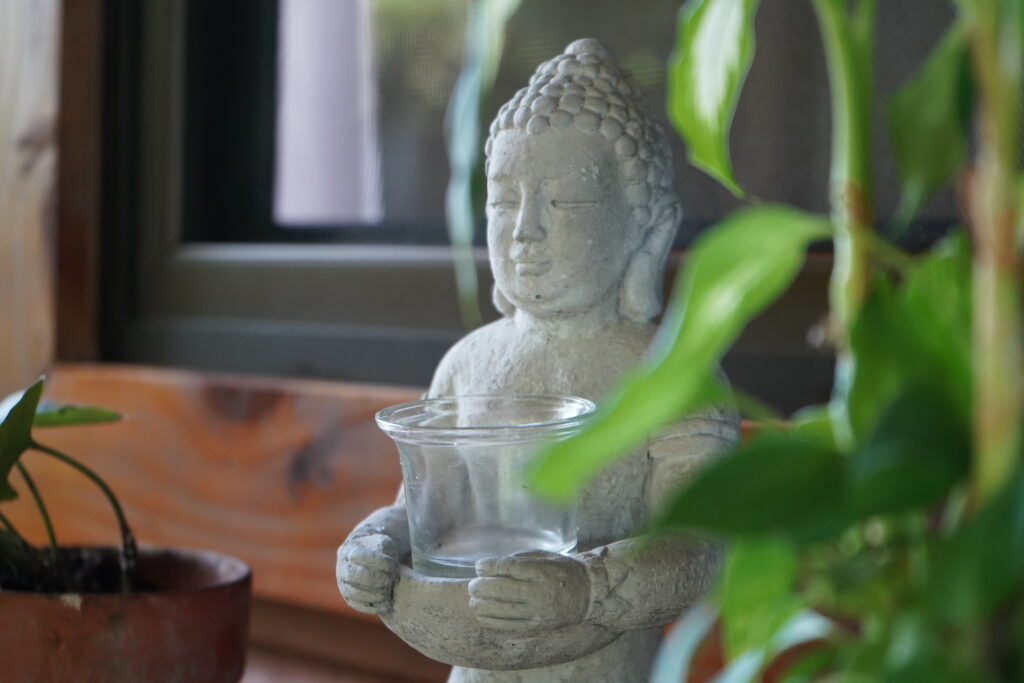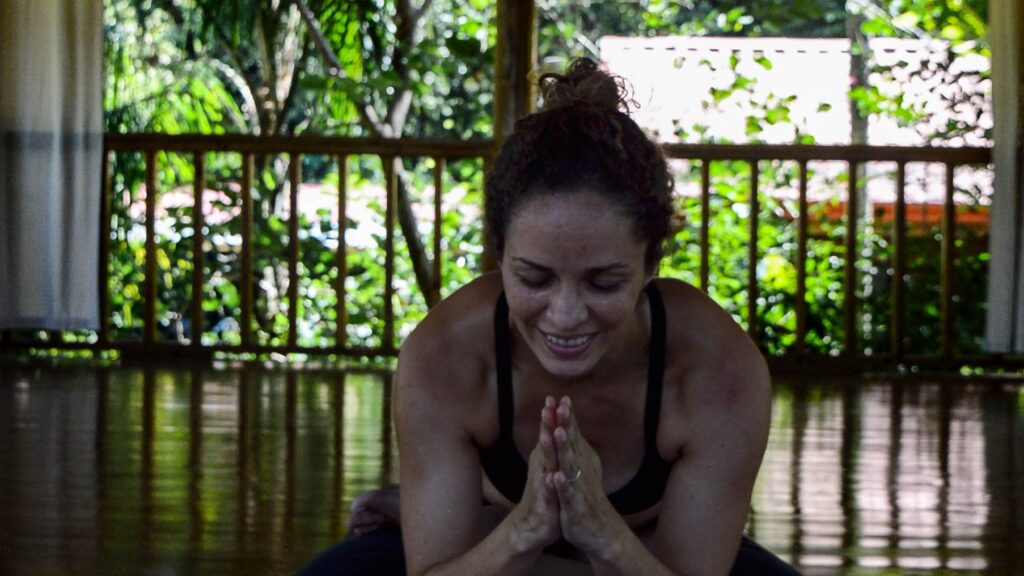Dharana is translated as a concentration of the mind and is the sixth limb of the eightfold path of Ashtanga Yoga. The goal of Dharana is to improve focus and is the first level of meditation, followed by Dhyana and Samadhi.
Meditation is a process that begins with learning to slow down, concentrate, and pay attention to our thoughts. It’s natural for our minds to be restless, with a constant stream of consciousness. For this reason, meditation can feel uneasy or unnatural at first.
Dharana requires freedom from distractions to concentrate the mind. Pratyahara, the previous limb, is meant to remove such external distractions and desires. Dharana, similar to Pratyahara, teaches us that meditation takes commitment and training. When our minds are well-prepared, meditation begins to feel effortless.

Practicing Dharana
The ability to concentrate, or still the mind, is often practiced after or in conjunction with Asana (physical postures) and Pranayama (breathwork) techniques. To practice Dharana, we focus our attention in one direction, noticing when the mind starts to wander, and gently bring it back to focus. All the previous limbs of Yoga help us reach this point of steady concentration.
Single-point or one-pointed meditation trains the mind to focus on a single object. As our mind wanders, we bring it back to focus repeatedly. Soon, all other sensory organs and the mind’s chatter fade. The goal is for the mind and the object to become one.
Awaken Your Ashtanga | Costa Rica Yoga Retreat
When we can focus the mind on a chosen object for an extended period, our thoughts become more apparent, calmer, and more stable. We are exercising the muscles of our mind, taking control of our inner dialogue. This practice has great potential for inner healing.
Being aware of what the mind is thinking and influencing to change your thought processes are massive steps for personal growth. The first step in this practice is acknowledging that you are not your thoughts, feelings, or emotions.
In a sense, meditation begins outside of meditation. It starts by constantly observing your thoughts and how you are moving, talking, and reacting. It starts by developing a state of constant awareness and being present in everything you do.

Ways to Concentrate the Mind
This practice means being mindful during menial tasks such as washing dishes and sweeping the floor. Focus on the task at hand and notice when the mind wanders. Take great care and attention to detail. This concentration can transform a lowly task into an activity that promotes well-being and happiness.
With that same mindfulness, we can also increase the well-being of others in our family. One of the greatest gifts we can give others is our complete attention. To be fully present and attentive to the ones we love is an act of great devotion.
The modern human mind trends toward restlessness, often referred to in Yoga as the monkey mind. External distractions constantly pull us away from ourselves and our loved ones. Dharana notices when the monkey mind takes over and brings your awareness back to the present moment. It is a practice of being present for the ones we love.
Other examples of practicing Dharanas are focusing on deep belly breaths, counting the inhales and exhales, holding an image in your consciousness, or repeating a meaningful mantra.
Pranayama—Focusing on the Breath
Focusing on breath is one of the most common ways to focus the mind, and it is used in Asana and Pranayama practice. Many yogis practice Ujjayi Breath, or breathing through the nose with a slight constriction at the back of the throat. This breath forces the airflow to be slow, steady, long, and deep.
Box Breathing is another technique to steady the breath and mind.
Step 1: Breathe in through the nose, counting to four slowly. Feel the air enter your chest, lungs, and belly.
Step 2: Hold your breath for four seconds.
Step 3: Slowly exhale through your nose for four seconds.
Step 4: Hold your breath at the bottom of the exhale for four seconds.
Step 5: Imagine in your mind’s eye each breath traces the four sides of a square.
Step 6: Repeat until calm

Visualization Meditation
An image or mental picture can also be valuable for prolonged concentration. For example, I like to imagine myself lying on the warm sand in the shade of a mangrove tree. I visualize myself gazing at the blue sky, watching the clouds pass overhead. I hear the wind blowing in the palms and smell the salt. I imagine my in-breath is the soothing waves washing up the beach, and my out-breath is the water level receding, pulling pebbles and shells back toward the big blue ocean.
As intrusive thoughts pop into my mind (what’s for dinner, for example), I gently place the thought into a cloud and watch as it floats into the horizon. I continue placing all unwanted thoughts into clouds and imagine a warm breeze wafting them away.
This type of visualization is beneficial before bed to calm the mind for a restful sleep. Practice anywhere from 5-20 minutes, setting a timer or soft music if necessary.
Maintaining a high degree of focused attention can lead to a meditative experience. Once the mind controls its distractions, it becomes easier to direct your awareness where you choose.
A Mantra Meditation
To practice a mantra meditation, choose a word, sentence, or expression that resonates with you. This can be a larger goal of well-being or something simple for each particular day or moment. Sit or lay comfortably with your eyes closed, focus on your breath, and silently or audibly repeat the mantra. It can be helpful to have two stanzas—one for the in-breath and one for the out-breath.
Breathing in: I am safe
Breathing out: I feel at ease.
Breathing in: I am strong
Breathing out: I am resilient.
There’s also a variety of traditional Yoga mantras you can use. Om, for example, is said to be the sound of the universe, and when pronounced fully, the vibration reverberates from the base of the spine through the crown of the head. The vibrations of this sound are also thought to stimulate the throat chakra and lead to better communication and honesty with others.

Practice Mindfulness
Here is another way Dharana can improve the intellect—When you feel an emotional reaction, stop and ask yourself: How do I feel? Do I want to change how I feel? Can I get out of this situation that is causing this emotion? What feeling has taken over me? Does it serve me or others? What are my actual needs in this situation? What sensations do I feel in my body?
Even this simple practice of identifying your thoughts and feelings in a stressful situation can go a long way to finding Dharana, the concentration of the mind.
“Whether this moment is happy or not depends on you. It`s you who makes the moment happy, not the moment that makes you happy. With mindfulness, concentration, and insight, any moment can become a happy moment.”
― Thich Nhat Hanh, The Art Of Living
There is no spontaneous moment when we can sit and immediately find a state of Samadhi or enlightenment. We must grant ourselves the time and space to be with our thoughts and see what is happening. All we can do is continue the practice and be open to improvement.
Likewise, meditation doesn’t only occur sitting on a pillow burning incense. It is a practice that can and should be incorporated into daily life. Try taking a walking meditation, slowly caressing the Earth with each step. Fold the laundry mindfully and thank the hands who crafted the textiles. Drink a cup of tea mindfully, focusing on the miracle of rain and sunshine that made the teabag a possibility.
The ability to concentrate comes with time—found in the seemingly insignificant moments of daily life. Remember that it is the journey that matters, not the destination. Practicing this consciousness and strong intellect will eventually lead you to the next limb, Dhyana.
Welcome to Yoga at Bodhi Surf + Yoga | Yoga with Pilar

Loving-Kindness Meditation
A Dharana meditation is one in which the mind focuses on a single point. In loving-kindness meditation, also known as metta meditation, the mind concentrates on a feeling of love. This practice increases compassion and kindness towards ourselves and others. It also improves our focus on positive bodily sensations, reducing unwanted distractions and thoughts.
To start, sit or lie comfortably and soften or close your eyes. Bring your awareness to the breath and allow your breathing to become slower and more profound. Scan your body from the head to the toes, reducing tension and feeling the weight of gravity grounding you to the Earth.
Start to repeat silently to yourself: May I be protected and safe. May I be healthy and strong? May I care for myself wisely? May I be at peace?
Notice the sensations this brings to your mind and body. Then, begin to visualize someone you love unconditionally. This shouldn’t be someone you have a complicated relationship with or whose presence may bring up negative or unresolved emotions.
I like to visualize my grandma, who died several years ago. She was the matriarch of our family who never failed to send a birthday card or attend a graduation. Imagine the person you love happy and restful. Send them loving-kindness by repeating the mantra: May you be happy, may you be healthy, may you be at ease.
May you be protected and safe.
May you be happy and at ease.
May you be healthy and strong.
May you care for yourself wisely.
May you be at peace.
Finally, we can extend these wishes of love and well-being to our friends, our neighbors, and finally to all the plants and animals alive on Mother Earth. I also encourage you to send loving-kindness to Mother Earth herself.
May all beings everywhere be protected and safe.
May all beings everywhere be happy and at ease.
May all beings everywhere be healthy and strong.
May all beings everywhere be at peace.
May all beings everywhere be happy and free.
Practice this meditation for 5-20 minutes during a break in your day, with your kids before bedtime, or as a seated meditation after an Asana practice. You can even practice during Savasana. This metta meditation increases the concentration of the mind but also fosters compassion and kindness, transforming our mindful awareness into peace on Earth.

Resources
Thron, Raji. Mastering Vinyasa Yoga: The Yoga Synthesis Guide to Dynamic Sequencing with Hundreds of Photos and Instructions (pp. 237-238). Yoga Synthesis. Kindle Edition.
Jakubowicz, Rina. The Yoga Mind: 52 Essential Principles of Yoga Philosophy to Deepen Your Practice (p. 106). Rockridge Press. Kindle Edition.

Your Journey Starts Here
Ready to Finally Experience That Life-Changing Surf + Yoga Trip (Without the Overwhelm)?
Bust the 5 biggest myths about going to a surf and yoga camp so you can stop procrastinating and start catching waves - with our FREE 5-day email course.
Change the heading on the Separator tab ->
Search
Get a Toolkit to Create Calm in Your Inbox
Watch the first lesson from our full immersive course: 8 Limbs of Ashtanga Yoga, FREE!
Change the heading on the Separator tab ->
Most Read Blogs
What is the Meaning of Anjali Mudra?
May 27, 2020
Fitness for Surfers: Workouts, Exercises & Training
February 10, 2022
The Best Places to Eat in Uvita, Costa Rica
May 19, 2022
How to Get From SJO to Costa Ballena, Costa Rica
May 31, 2018
Change the heading on the Separator tab ->
Categories
Categories
- Bodysurfing (5)
- Food (7)
- Responsible Business (6)
- Surfing (66)
- Travel (65)
- Yoga (43)
Change the heading on the Separator tab ->
Newsletter
Thanks for subscribing! Please check your email for further instructions.
Change the heading on the Separator tab ->
Follow Us
Carly Stoenner
Change the heading on the Separator tab ->
Read more
Agni – Ayurveda’s Most Vital and Dynamic Principle
Words by Pilar
What if we told you that you could change your life by reading just one blog post? While that might be a bit far fetched, we’re convinced that we could all benefit…
Intro to Ayurveda: Pilar’s Exploration into the Ancient Science of Longevity
Words by Pilar
If you’ve visited us recently and spent time with Pilar specifically — whether on the yoga mat or over breakfast, you’ve likely heard her mention the word “Ayurveda” multiple times. That’s no…
5 Advanced PNF Stretches for Surfing
Words by Guest Post
Like in any sport, surfing requires exceptional mobility and range of motion in the joints. Stretching is a great tool to gain mobility for those eye-catching maneuvers or a post-session recovery routine….



